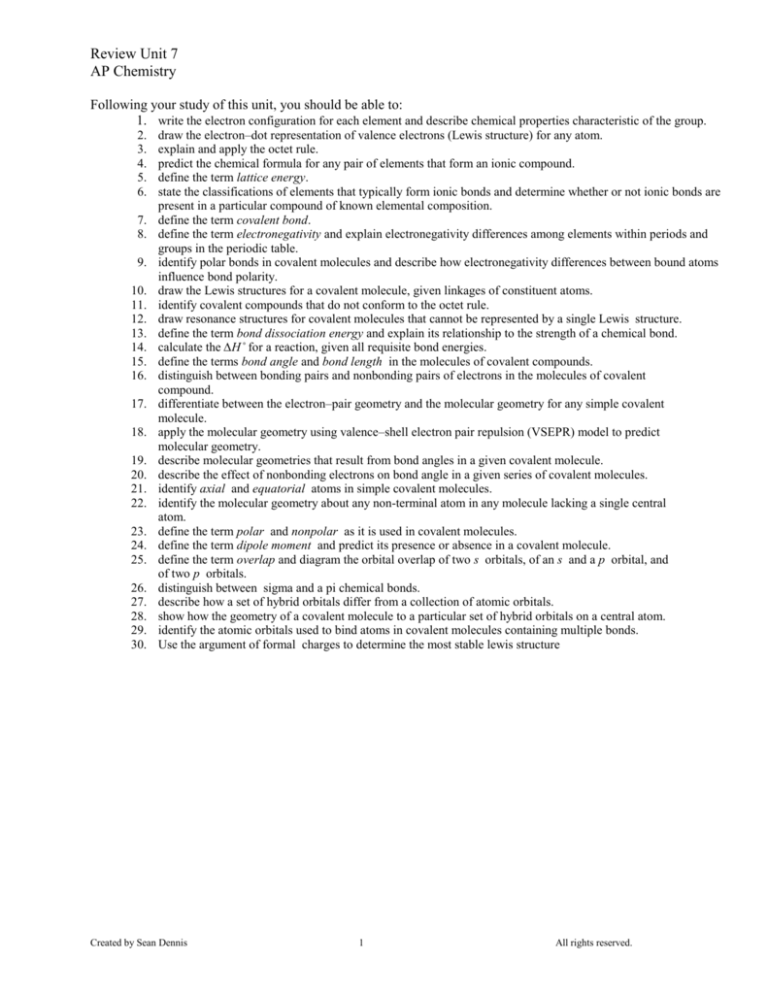
Review Unit 7
AP Chemistry
Following your study of this unit, you should be able to:
1. write the electron configuration for each element and describe chemical properties characteristic of the group.
2.
3.
4.
5.
6.
7.
8.
9.
10.
11.
12.
13.
14.
15.
16.
17.
18.
19.
20.
21.
22.
23.
24.
25.
26.
27.
28.
29.
30.
draw the electron–dot representation of valence electrons (Lewis structure) for any atom.
explain and apply the octet rule.
predict the chemical formula for any pair of elements that form an ionic compound.
define the term lattice energy.
state the classifications of elements that typically form ionic bonds and determine whether or not ionic bonds are
present in a particular compound of known elemental composition.
define the term covalent bond.
define the term electronegativity and explain electronegativity differences among elements within periods and
groups in the periodic table.
identify polar bonds in covalent molecules and describe how electronegativity differences between bound atoms
influence bond polarity.
draw the Lewis structures for a covalent molecule, given linkages of constituent atoms.
identify covalent compounds that do not conform to the octet rule.
draw resonance structures for covalent molecules that cannot be represented by a single Lewis structure.
define the term bond dissociation energy and explain its relationship to the strength of a chemical bond.
calculate the ∆H˚ for a reaction, given all requisite bond energies.
define the terms bond angle and bond length in the molecules of covalent compounds.
distinguish between bonding pairs and nonbonding pairs of electrons in the molecules of covalent
compound.
differentiate between the electron–pair geometry and the molecular geometry for any simple covalent
molecule.
apply the molecular geometry using valence–shell electron pair repulsion (VSEPR) model to predict
molecular geometry.
describe molecular geometries that result from bond angles in a given covalent molecule.
describe the effect of nonbonding electrons on bond angle in a given series of covalent molecules.
identify axial and equatorial atoms in simple covalent molecules.
identify the molecular geometry about any non-terminal atom in any molecule lacking a single central
atom.
define the term polar and nonpolar as it is used in covalent molecules.
define the term dipole moment and predict its presence or absence in a covalent molecule.
define the term overlap and diagram the orbital overlap of two s orbitals, of an s and a p orbital, and
of two p orbitals.
distinguish between sigma and a pi chemical bonds.
describe how a set of hybrid orbitals differ from a collection of atomic orbitals.
show how the geometry of a covalent molecule to a particular set of hybrid orbitals on a central atom.
identify the atomic orbitals used to bind atoms in covalent molecules containing multiple bonds.
Use the argument of formal charges to determine the most stable lewis structure
Created by Sean Dennis
1
All rights reserved.
1. Which of the following salts has the largest lattice energy? Explain.
LiF, LiCl, LiBr, LiI
2. Predict whether the following compounds are ionic or covalent.
SiCl4, MgBr2, PH3, NH4Cl, HCl, Al2O3
3. Arrange the following elements from smallest to largest electronegativity.
O, Al, Ga, I, H, Na
4. Determine the ∆H of the reaction for the following:
C2H2 + 2H2 --> C2H6
5. Draw resonance structures for C6H6 ( the carbons are in a ring) and tell how the bond length
would compare to a single and a double bond.
Created by Sean Dennis
2
All rights reserved.
6. For the following molecules determine the following.
i) electronic geometry
ii) molecular geometry
iii) polarity
iv) hybridization
NH3
O3
SF4
ClF3
XeF2
XeF4
7. Use formal charges to determine which structure will be the most stable.
1
Created by Sean Dennis
••
N
••
N
••
O
••
••
N
••
3
N
••
••
O
••
••
N
••
••
N
3
2
O
All rights reserved.









